Many dozens of native Missouri plants find homes in Nadia’s Backyard (and front yard, too!), and we love ’em all. But I think Nadia and I are in agreement that we are especially fond of those that, along with providing habitat, enriching soil, and feeding pollinators, also feed us.
I mean that literally, as in providing stuff that we can eat, drink, otherwise use to enhance our culinary adventures in life. Cue American dittany. You notice the scientific name, Cunila origanoides, bears a resemblance to something that most home cooks have in their kitchens? (Hint: especially if they make Italian food on occasion?)
Did you guess “oregano”? Because if you did you just won an invitation to come by and sample my homemade bread flavored with dried and crushed leaves of dittany.
More on the oregano connection in a bit, but first let’s get a little business done.
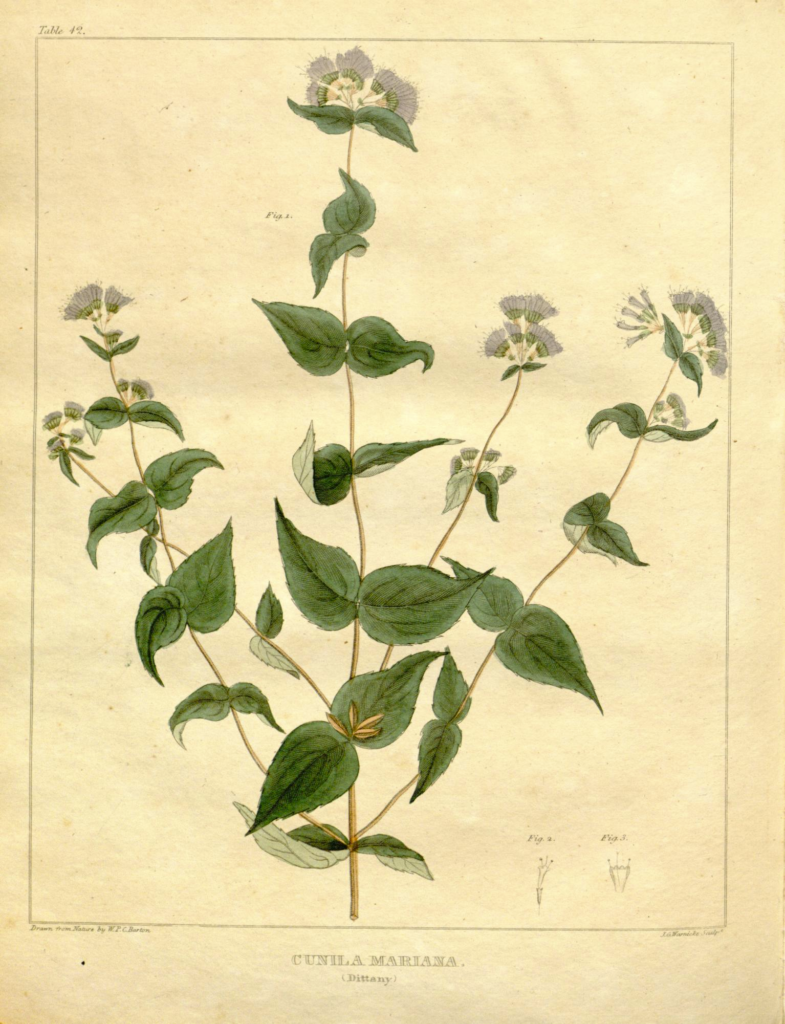
Illustration by William P.C. Barton (1828). Vegetable materia medica of the United States, or, Medical botany. Vol. 2 Plate 42. As found in the Biodiversity Heritage Library. Note: C. mariana is a synonym for C. origanoides.
American Dittany, according to the Missouri Botanical Garden, “is a Missouri native plant which grows 8-16″ tall and typically occurs in dry, rocky, or open woods, clearings, slopes and prairies. A mint family member which features many-branched, square, wiry stems and clusters of small, purplish (rarely white), two-lipped flowers (note the 2 long protruding stamens and pistil) arising from the leaf axils in mid-summer to fall. Oval, serrated, stalkless leaves are pleasantly aromatic.” From mid-summer to early fall, it puts out its small, lavender blooms that are tiny, but very attractive. I wouldn’t describe it as an overly showy plant, but it has its charms.
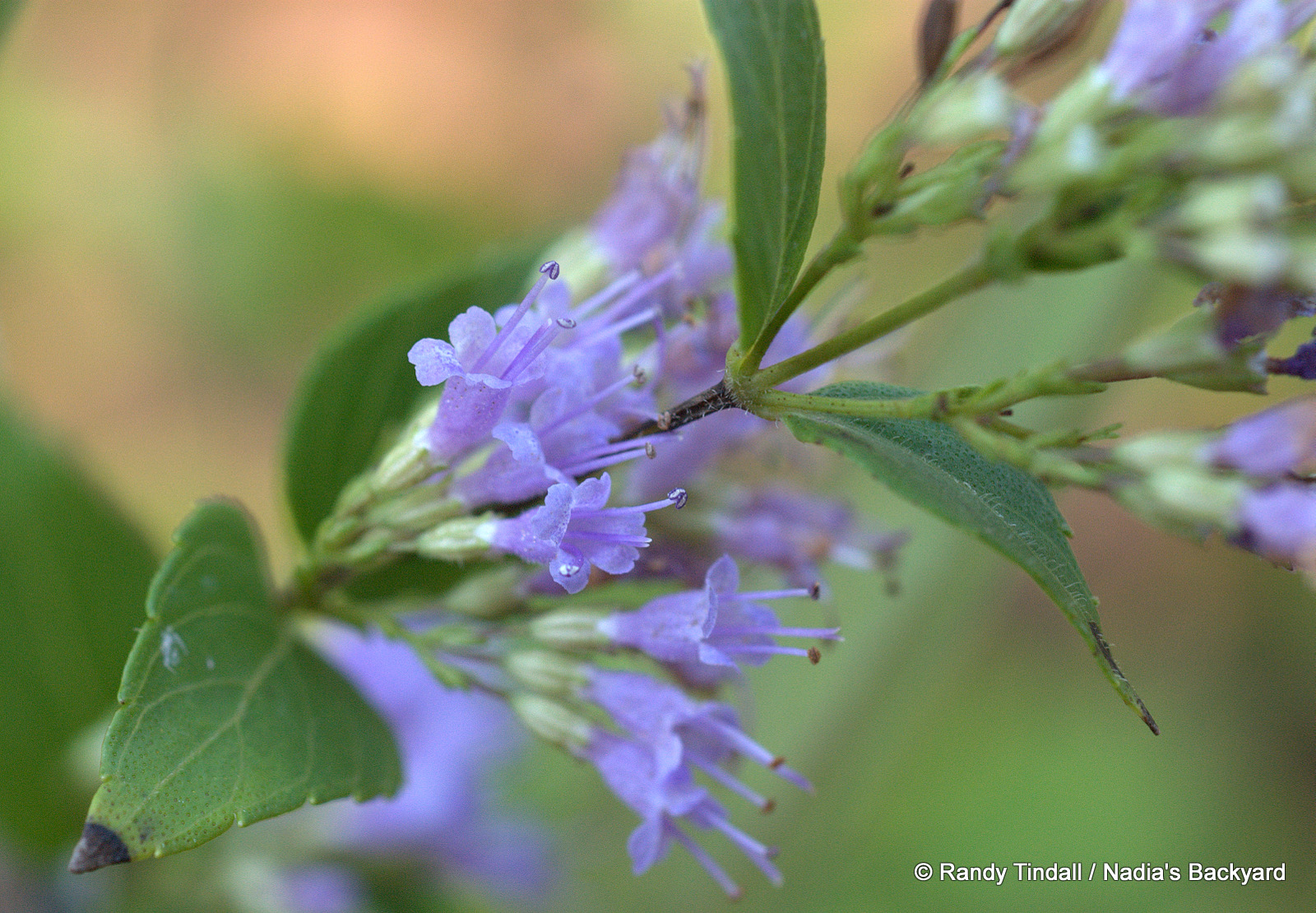
Opinion seems to be that propagating this plant is most easily done via cuttings:
“Propagation of dittany is seldom covered in popular books or in the body of academic literature. The seeds, which are extremely small, are rarely for sale. If you collect the seed, be prepared for containing what has been described as dust-like seed. However, being a mint, it is easily propagated by stem cuttings in the spring and summer. You should see root initiation in 7 to 10 days. A low concentration of rooting hormone may be used, but it is not necessary. It is also easily divided in the summer. It will self-seed in the garden much like its namesake, oregano, but the seedlings are easily removed and transplanted or composted.”
That said, dittany’s tiny seeds do just fine to keep the population size growing slowly, like ours has over the years. Once you’ve got a few, you will get more eventually.
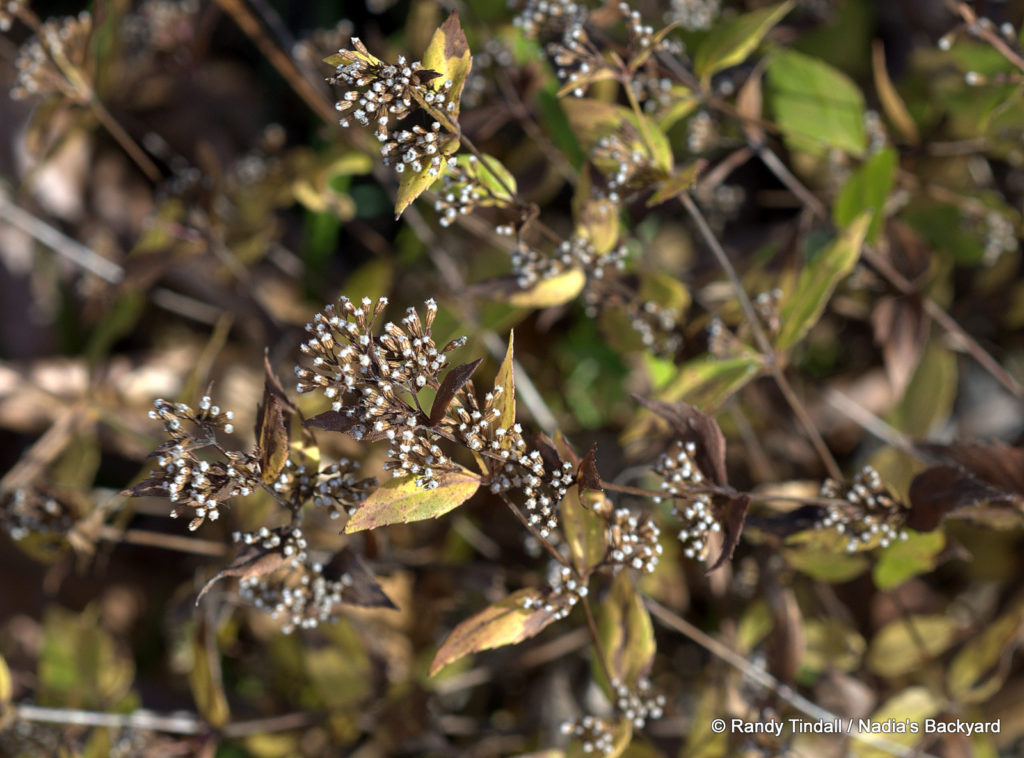
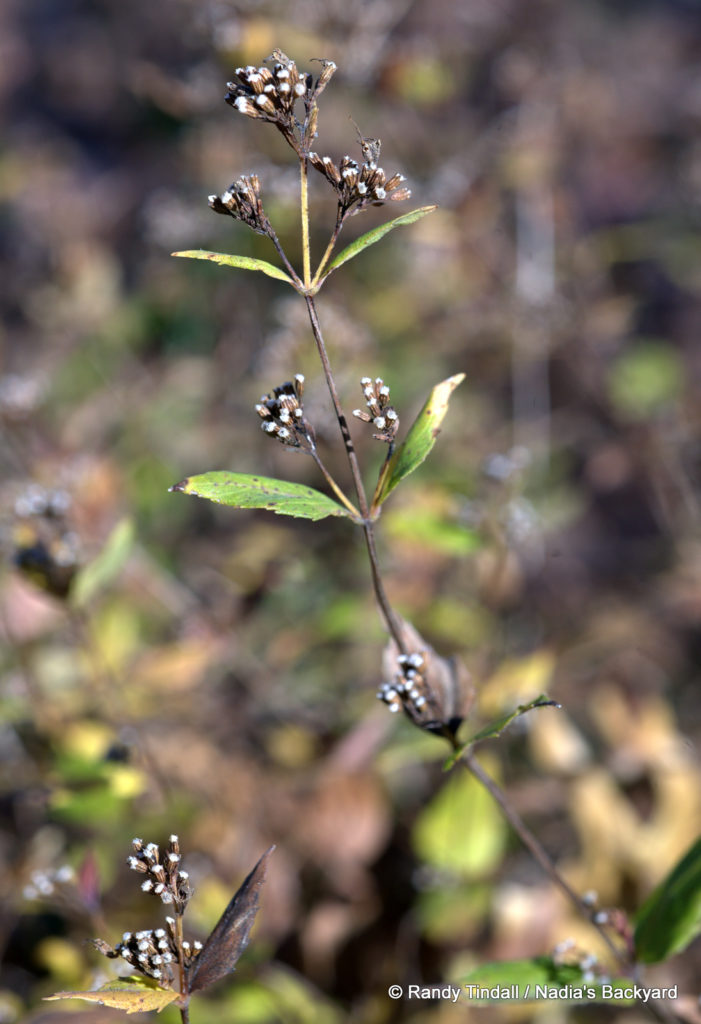
American dittany’s faunal associations are apparently not very well known, but it does seem to provide nectar to some beetles, flies, and bees, as well as to monarch butterflies. Nadia says she sees “small insects” hanging around on the small blossoms, so one of my odd jobs this summer will be to try and document what some of these are. I’ll get back to you….
In our yard, we have our main patch close to the sidewalk on the west side of the house, where it does just fine, thank you, with morning shade to partial sun and full sun in late afternoon on a slight slope, a little like a mini-glade. The clayey soil is recovering from the turf grass that was there when we arrived lo these many years ago, with low to medium moisture. Our dittany gets watered only by rain and has calmly survived a couple extended dry spells with no complaints. It never suffers from any pests that we’ve noticed, and it is well-behaved, spreading very slowly in its perennial rounds.

American dittany, or common dittany, is to be distinguished from Cretan dittany (Origanum dictamnus), which has a much more romantic and heroic pedigree, including inclusion in Virgil’s Aeneid, Greek mythology, and the Harry Potter stories. Alas, our American dittany is not that one. But, as we shall see, it has its own special qualities.
Take some of its other names, for starters: stonemint, sweet horsemint, frost mint, frost flowers and, my favorite, fairy skirts. Those last three monikers refer to its habit of forming frost flowers in the early freezes of autumn, when water rising in its conductive tissue can be forced out through cracks in the stem near the base and freeze, forming beautiful curling, wavy sculptures of ice.
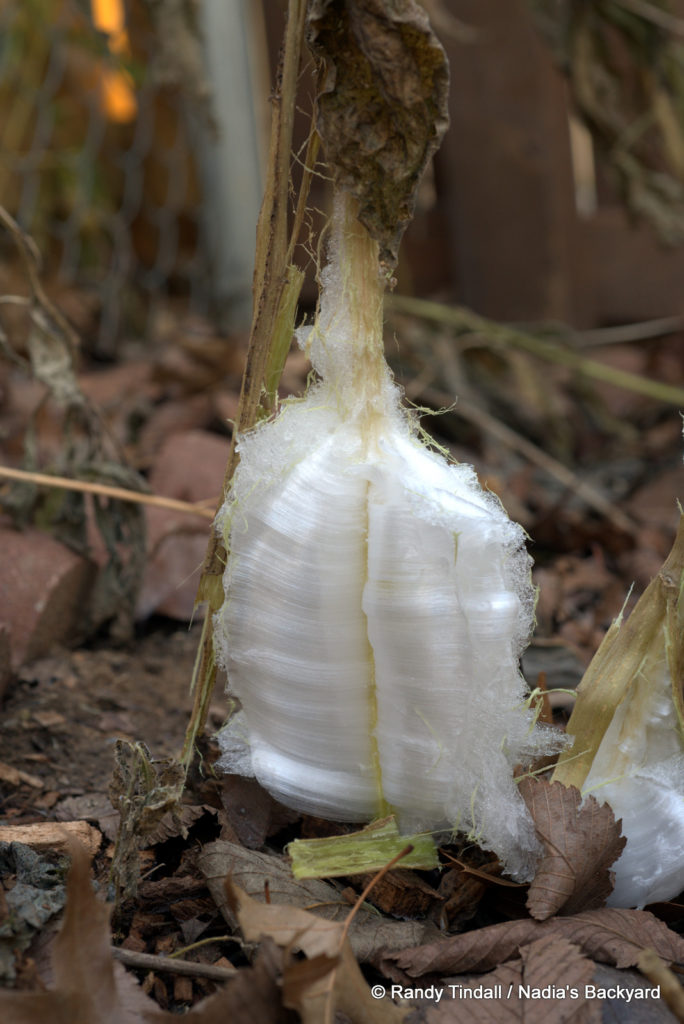
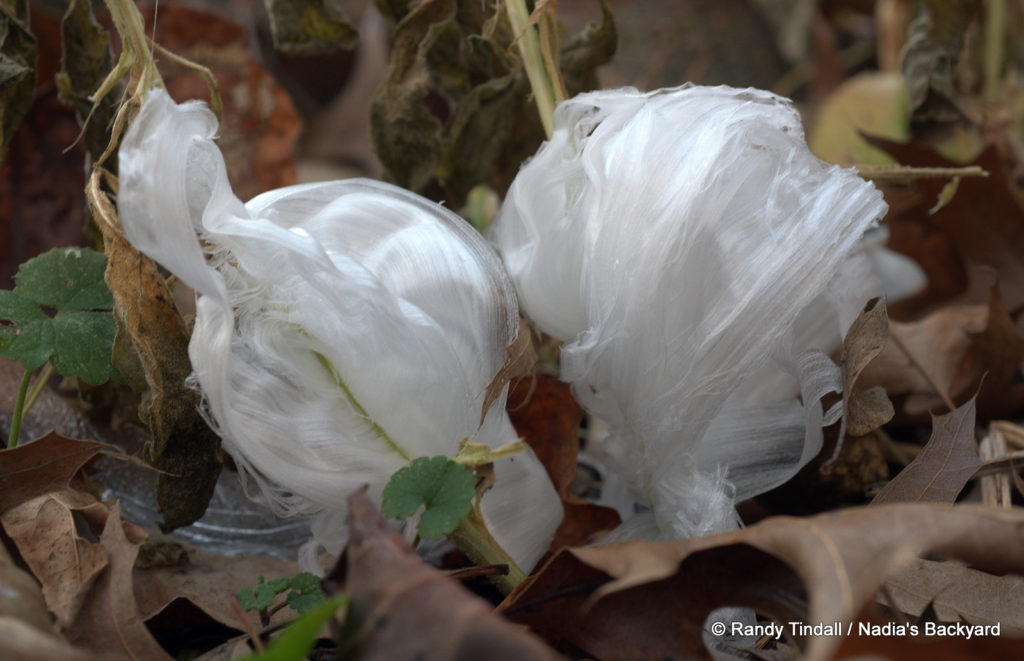
Frost flowers and fairy skirts.
But our dittany’s outstanding feature, at least in my opinion, is its olfactory resemblance to oregano, a characteristic due at least in part to the presence of carvacrol, a “phenolic monoterpenoid found in essential oils of oregano (Origanum vulgare), thyme (Thymus vulgaris), pepperwort (Lepidium flavum), wild bergamot (Citrus aurantium bergamia), and other plants.” Now you know what THAT’s all about.
But let’s put it in other terms, as the folks at Sovereignty Herbs did so beautifully:
“Crushing a leaf of American Dittany between one’s fingers and gently inhaling its aroma, sparks sensations of warmth or heat in the nose and sinuses. For those who feel the need to identify in order to ‘know’, the fragrance of American Dittany is akin to fresh culinary Oregano (hence one of its common names, Wild Oregano). However, it is a sharper, more cutting aroma than the culinary species exudes. As if the plant, living in the wilds, has produced such extravagant defense mechanisms that no other species, fairy or otherwise, would even dare consume it.
“However, describing the aroma as ‘hot’, ‘sharp’, and ‘cutting’ sounds much more aggressive than the experience of the aroma feels. The feeling produced is one of comfort and familiarity, of centuries-old medicinal relationships between plants and people. Yes, it is very much a ‘medicinal’ fragrance, one that an herbalist walking through a native ecosystem would immediately recognize as anti-infective, diffusive, stimulating.
“Equally so…upon inhaling the aroma of American Dittany deeply into one’s imagination, warming images of crackling bonfires, fiddles, ale, and dancing upon moss-covered fairy hills, invigorate the mind’s eye. Yes, there is also magic in this medicine…”
And medicine it is, to many people. A review article on carvacrol mentioned above cites claims that it has antimicrobial, antioxidant, and anticancer properties. Other sources claim that helps to induce perspiration, relieve flatulence, and can work with other herbals as an antispasmodic. Doing an internet search on “oil of oregano” reveals many, many links for health claims for this essential oil, including many trusted, mainstream medical sites.
So, inquiring minds might ask, why would a plant produce such a distinctive and odorous substance? Well, it seems that, along with medicinal properties, carvacrol also discourages plant pests, such as insect larvae and even vertebrates that might otherwise snack on the plant producing it. It has even been considered as a candidate in integrated pest management, or the use of natural pest controls in agriculture rather than artificial pesticides with all of their dangers. Mints, in general, are often resistant to vertebrates like deer or groundhogs, and carvacrol seems to be one of the reasons why. American dittany is often described as having few, if any, problems with insects and diseases, and, as mentioned above, our patch seems to bear this out. This plant’s no dummy.
So, all in all, we find this fragrant native to be a worthy and welcome addition to our yard. It’s pretty, well-behaved, insect-friendly, almost pest- and maintenance-free, and can be used in cooking. And if that’s not enough, if you keep your eyes peeled on a cold, wintry morning, you just might catch a glimpse of fairy skirts!

